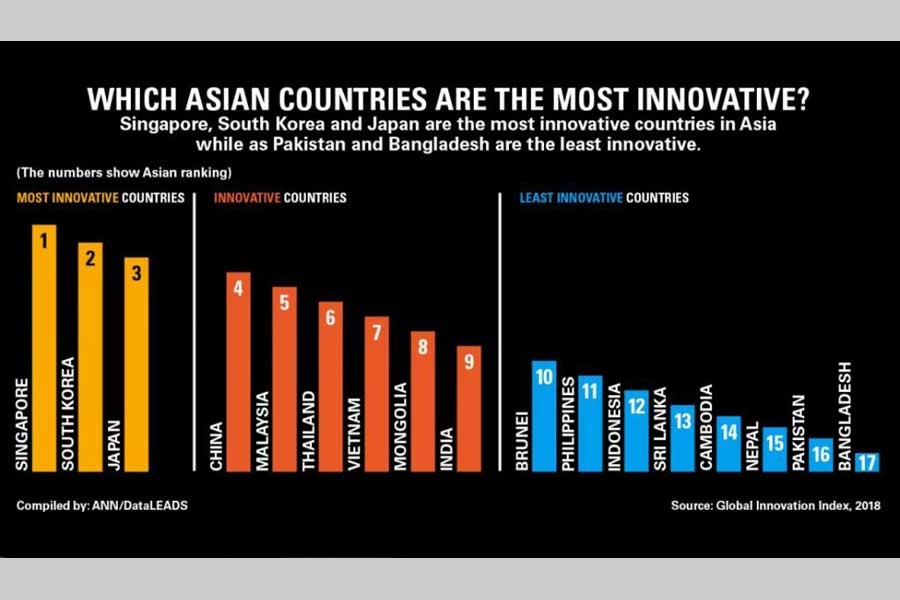It is quite distressing to know that Bangladesh is the least innovative country in Asia. The country finds itself at the bottom of the list of the South-east Asian countries in terms of innovation. That it is ranked the last behind Pakistan and Nepal in the Global Innovation Index 2018 is also a cause for serious concern. If the South East Asia, as a region, occupies the third position globally, Bangladesh's position in the global innovation index may not be as deplorable as it looks from the South-east Asian perspective. But when it finds its place in the least innovative cluster comprising Kazakhstan, Sri Lanka, Nepal and Pakistan, it does not enhance the country's record in the area. Surprisingly, Mongolia is one notch ahead of India placed ninth.
Singapore, a small island nation, is leading the pack in the race for innovation in the region. The next two positions are held by South Korea and Japan. However the popular perception was that Japan with its long tradition of technological advancement might have been way ahead of the rest. If it were not Japan, the laurel could go to China which has been the main source of a wide range of the cheapest implements and gadgets starting from safety pins to calculators and clever toys to smart phones. Now what criteria were applied to decide the level of inventiveness is not known but about one thing there is a clear indication of the extent of innovation and its practical use for social development.
There may be innovation that outpaces social development. Mere technological innovations sans society's adaptation to those through social rules, customs and culture cannot be desirably productive. Thailand and India are the countries that have scored high on innovation at a level that has outperformed their scale of development. Bangladesh is not a small country like Singapore, nor is it as large as India. But it is a highly populous country and must of necessity go for invention in order to ensure that the population is well fed and have a decent living standard.
So the focus should be on creation of technological knowledge and gadgets environmentally sound for the local conditions. What makes the difference in performance of nations in this respect is the scientific and technological base. How Singapore has gone about the business is not clear. But its universities' top ranking in the region may be a clue to the nation's achievement on the innovation front. Behind the success of South Korea in the field lies its investment in innovation and improved performance in scientific publications along with improvement in the quality of its universities. The same has been said about China ranked fourth. Its global research and development (R&D) companies, high-tech imports, quality of publications and tertiary enrolment show its innovative prowess.
It is exactly on this front, Bangladesh lags behind many of its neighbours. Universities here are not getting enough funds to conduct research and experiment. Research institutes are conspicuous more by their absence or lack of facilities for advanced research. The International Centre for Diarrhoeal Diseases Research, Bangladesh (ICDDRB) is credited with a few groundbreaking innovations, one of those being the simple oral saline. This research centre could do so because fund from international sources was available for research and experiment.
The country's lone research organisation, Bangladesh Council of Scientific and Industrial Research (BCSIR) has been in the forefront of invention. Some of its technologies and devices in the field of agriculture in particular have been highly suitable for adoption at the grassroots level. But then there is a wide gap between some of the inventions and the cultural adoption all across the country.
Yet the latest invention of a simple method for screening human blood for detection of cancer may transform the country's landscape of scientific innovation. Then the genome sequencing of Hilsa by a team of Bangladesh scientists also adds to the list of scientific performance. If the simple and cheap method of cancer detection can bring about a revolutionary change in fighting the disease the world over, the achievements by a scientist from this soil but working at the University of Princeton, the USA Zahid Hasan proposes to transform the world of information, communications and electronics. But his is an achievement beyond the country's border. Yet one thing is clear that the country's innovation footprint and research inventory could be much richer.
This points to the fact that the country must review its outlook on scientific research and technological invention. True, fundamental research costs heavily but technological advancement is not comparably costly particularly when devices used for simplifying processes at the grassroots level are concerned. The research and experiment at the Shahjalal University of Science and Technology will serve as the finest example of this. So, the country now needs to develop a solid base of such research works. Creation of knowledge at the tertiary level of education should be made inclusive rather than an erratic exercise. Educational reform is in order for it to respond to the demand of the time. Innovation does not happen in the limbo; proper atmosphere has to be created for nurturing the tradition and culture.


